Page 18 of 429
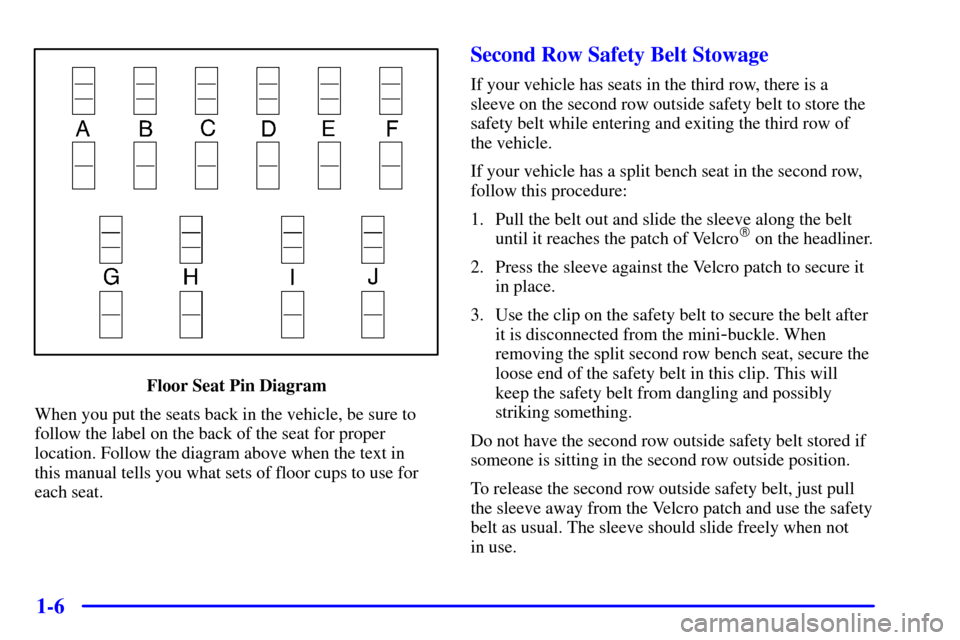
1-6
Floor Seat Pin Diagram
When you put the seats back in the vehicle, be sure to
follow the label on the back of the seat for proper
location. Follow the diagram above when the text in
this manual tells you what sets of floor cups to use for
each seat.
Second Row Safety Belt Stowage
If your vehicle has seats in the third row, there is a
sleeve on the second row outside safety belt to store the
safety belt while entering and exiting the third row of
the vehicle.
If your vehicle has a split bench seat in the second row,
follow this procedure:
1. Pull the belt out and slide the sleeve along the belt
until it reaches the patch of Velcro
� on the headliner.
2. Press the sleeve against the Velcro patch to secure it
in place.
3. Use the clip on the safety belt to secure the belt after
it is disconnected from the mini
-buckle. When
removing the split second row bench seat, secure the
loose end of the safety belt in this clip. This will
keep the safety belt from dangling and possibly
striking something.
Do not have the second row outside safety belt stored if
someone is sitting in the second row outside position.
To release the second row outside safety belt, just pull
the sleeve away from the Velcro patch and use the safety
belt as usual. The sleeve should slide freely when not
in use.
Page 42 of 429
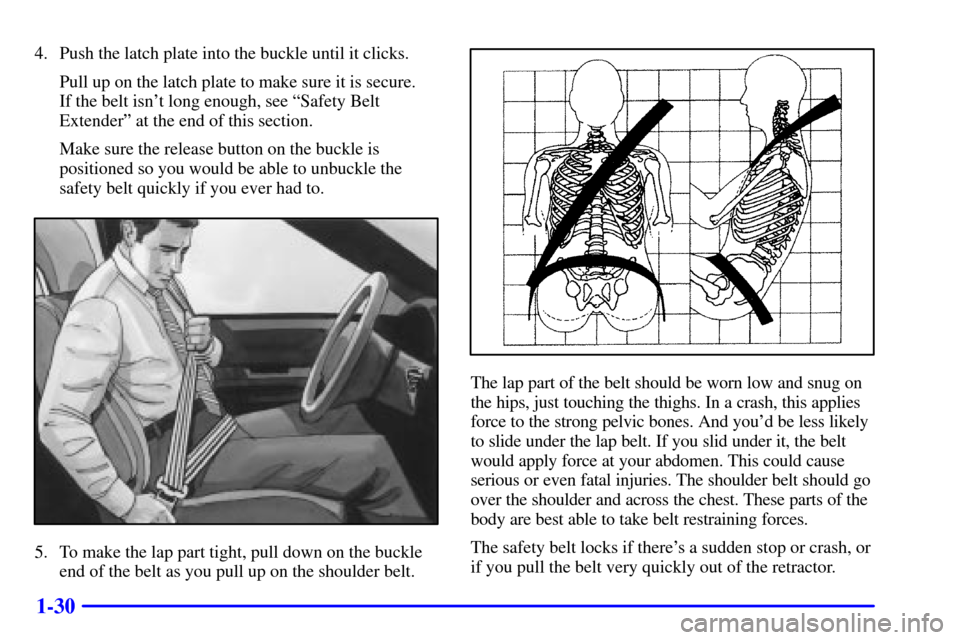
1-30
4. Push the latch plate into the buckle until it clicks.
Pull up on the latch plate to make sure it is secure.
If the belt isn't long enough, see ªSafety Belt
Extenderº at the end of this section.
Make sure the release button on the buckle is
positioned so you would be able to unbuckle the
safety belt quickly if you ever had to.
5. To make the lap part tight, pull down on the buckle
end of the belt as you pull up on the shoulder belt.
The lap part of the belt should be worn low and snug on
the hips, just touching the thighs. In a crash, this applies
force to the strong pelvic bones. And you'd be less likely
to slide under the lap belt. If you slid under it, the belt
would apply force at your abdomen. This could cause
serious or even fatal injuries. The shoulder belt should go
over the shoulder and across the chest. These parts of the
body are best able to take belt restraining forces.
The safety belt locks if there's a sudden stop or crash, or
if you pull the belt very quickly out of the retractor.
Page 52 of 429
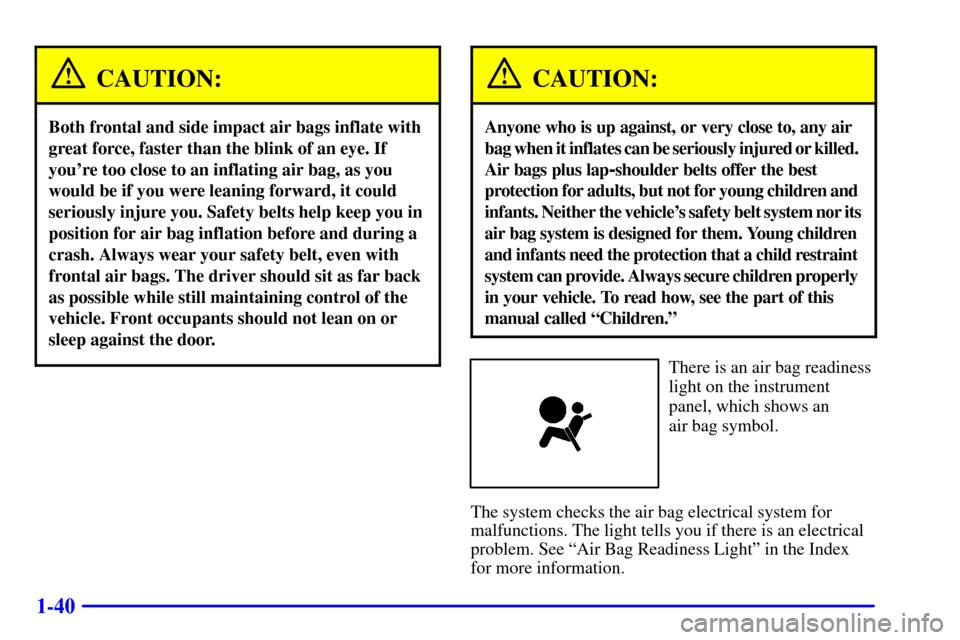
1-40
CAUTION:
Both frontal and side impact air bags inflate with
great force, faster than the blink of an eye. If
you're too close to an inflating air bag, as you
would be if you were leaning forward, it could
seriously injure you. Safety belts help keep you in
position for air bag inflation before and during a
crash. Always wear your safety belt, even with
frontal air bags. The driver should sit as far back
as possible while still maintaining control of the
vehicle. Front occupants should not lean on or
sleep against the door.
CAUTION:
Anyone who is up against, or very close to, any air
bag when it inflates can be seriously injured or killed.
Air bags plus lap
-shoulder belts offer the best
protection for adults, but not for young children and
infants. Neither the vehicle's safety belt system nor its
air bag system is designed for them. Young children
and infants need the protection that a child restraint
system can provide. Always secure children properly
in your vehicle. To read how, see the part of this
manual called ªChildren.º
There is an air bag readiness
light on the instrument
panel, which shows an
air bag symbol.
The system checks the air bag electrical system for
malfunctions. The light tells you if there is an electrical
problem. See ªAir Bag Readiness Lightº in the Index
for more information.
Page 60 of 429
1-48
2. Push the latch plate into the buckle until it clicks.
Second Row Outside Passenger Positions
Third Row Outside Passenger Positions
If the belt stops before it reaches the buckle, tilt the
latch plate and keep pulling until you can buckle it.
Pull up on the latch plate to make sure it is secure.
On some vehicles, when the shoulder belt is pulled
out all the way, it will lock. If it does, let it go back
all the way and start again. If the belt is not long
enough, see ªSafety Belt Extenderº at the end of this
section. Make sure the release button on the buckle is
positioned so you would be able to unbuckle the
safety belt quickly if you ever had to.
Page 67 of 429
1-55
When you sit in the center position bucket seat, you
have a lap safety belt which has a retractor.
1. Pick up the latch plate and, in a single motion, pull
the belt across you. Don't let it get twisted.
2. Push the latch plate into the buckle until it clicks.
If the belt stops before it reaches the buckle, let it go
back all the way and start again. Pull up on the latch
plate to make sure it is secure.
3. Feed the lap belt into the retractor to tighten it.4. Position and release it the same way as the lap part
of a lap
-shoulder belt.
If the belt isn't long enough, see ªSafety Belt
Extenderº at the end of this section. Make sure the
release button on the buckle is positioned so you
would be able to unbuckle the safety belt quickly if
you ever had to.
Page 68 of 429
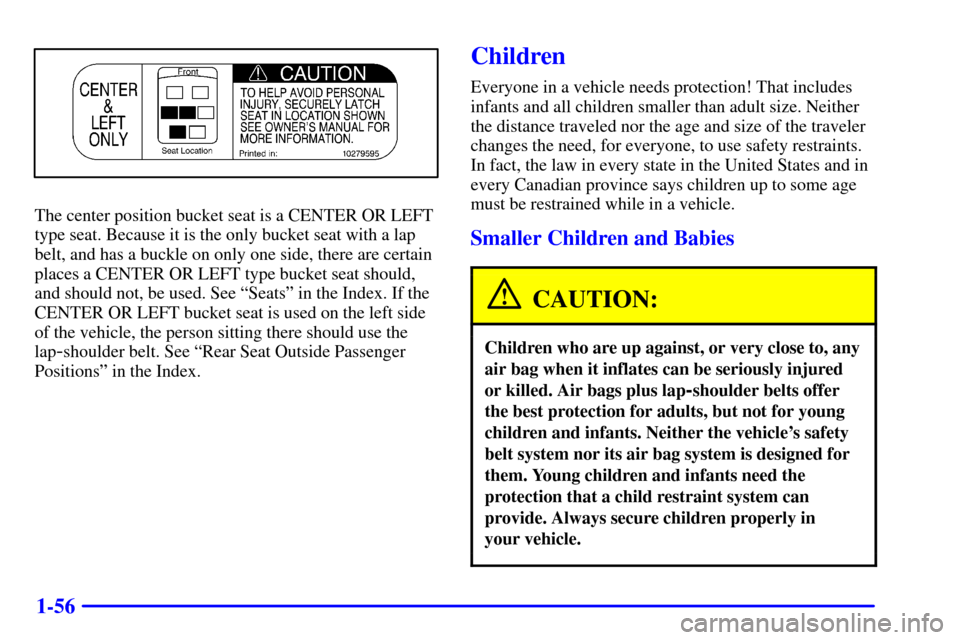
1-56
The center position bucket seat is a CENTER OR LEFT
type seat. Because it is the only bucket seat with a lap
belt, and has a buckle on only one side, there are certain
places a CENTER OR LEFT type bucket seat should,
and should not, be used. See ªSeatsº in the Index. If the
CENTER OR LEFT bucket seat is used on the left side
of the vehicle, the person sitting there should use the
lap
-shoulder belt. See ªRear Seat Outside Passenger
Positionsº in the Index.
Children
Everyone in a vehicle needs protection! That includes
infants and all children smaller than adult size. Neither
the distance traveled nor the age and size of the traveler
changes the need, for everyone, to use safety restraints.
In fact, the law in every state in the United States and in
every Canadian province says children up to some age
must be restrained while in a vehicle.
Smaller Children and Babies
CAUTION:
Children who are up against, or very close to, any
air bag when it inflates can be seriously injured
or killed. Air bags plus lap
-shoulder belts offer
the best protection for adults, but not for young
children and infants. Neither the vehicle's safety
belt system nor its air bag system is designed for
them. Young children and infants need the
protection that a child restraint system can
provide. Always secure children properly in
your vehicle.
Page 69 of 429
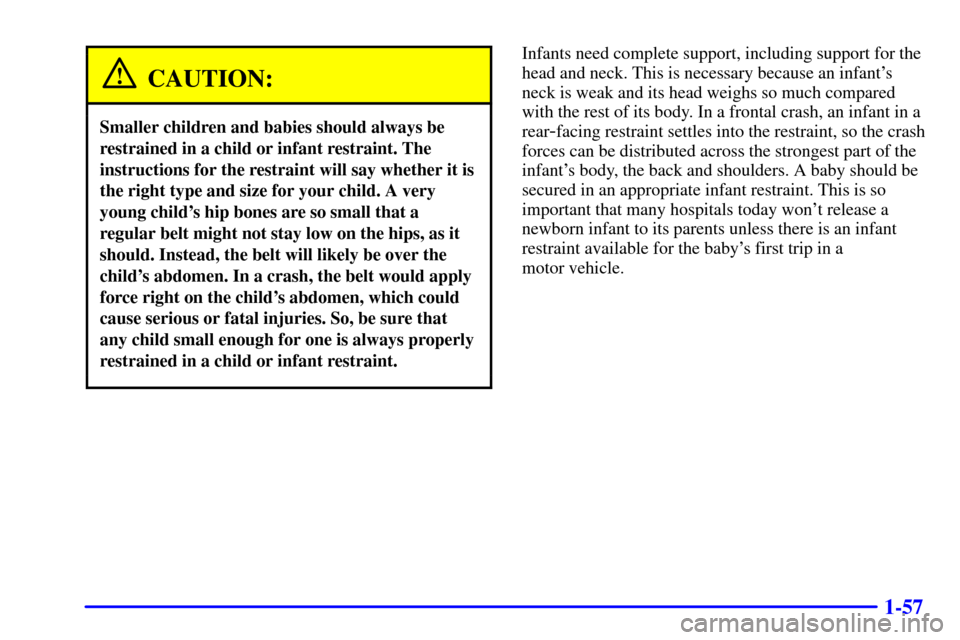
1-57
CAUTION:
Smaller children and babies should always be
restrained in a child or infant restraint. The
instructions for the restraint will say whether it is
the right type and size for your child. A very
young child's hip bones are so small that a
regular belt might not stay low on the hips, as it
should. Instead, the belt will likely be over the
child's abdomen. In a crash, the belt would apply
force right on the child's abdomen, which could
cause serious or fatal injuries. So, be sure that
any child small enough for one is always properly
restrained in a child or infant restraint.
Infants need complete support, including support for the
head and neck. This is necessary because an infant's
neck is weak and its head weighs so much compared
with the rest of its body. In a frontal crash, an infant in a
rear
-facing restraint settles into the restraint, so the crash
forces can be distributed across the strongest part of the
infant's body, the back and shoulders. A baby should be
secured in an appropriate infant restraint. This is so
important that many hospitals today won't release a
newborn infant to its parents unless there is an infant
restraint available for the baby's first trip in a
motor vehicle.
Page 70 of 429
1-58
CAUTION:
Never hold a baby in your arms while riding in a
vehicle. A baby doesn't weigh much
-- until a
crash. During a crash a baby will become so
heavy you can't hold it. For example, in a crash
CAUTION: (Continued)
CAUTION: (Continued)
at only 25 mph (40 km/h), a 12-lb. (5.5 kg) baby
will suddenly become a 240
-lb. (110 kg) force on
your arms. The baby would be almost impossible
to hold.
Secure the baby in an infant restraint.